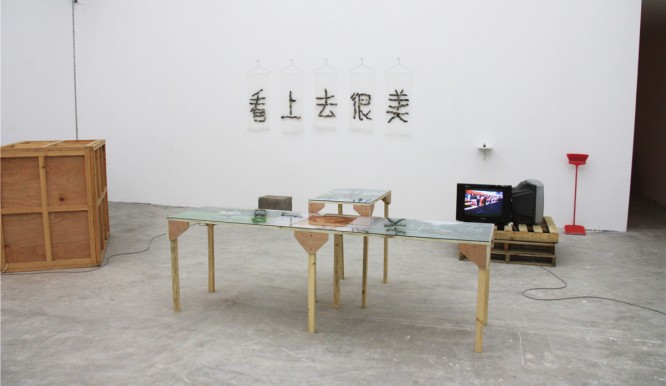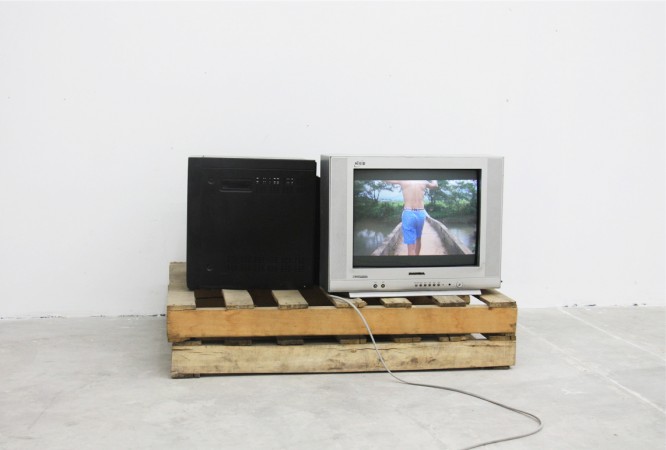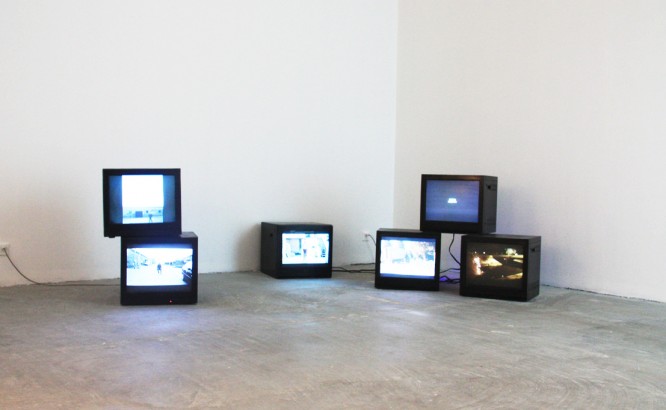“I Have Issues“: Li Binyuan solo exhibiton
Gallery Yang (Unit 47&48, N2 Building, North Village Sanlitun Road, Chaoyang Distric Beijing, China) Aug 24—Sept 22, 2013
A magician can astonish, surprise and make one reconsider. A good magician does not rely on tricks; instead, he transmutes the most unassuming visual sleight of hand into a heightened arena of elegance and amusement. An inexperienced magician rehearses illusions — untransformed, resulting in a lifeless rendition which burdens the audience with doubt and repetition. But the greatest of performers and magicians can lift our minds away from the realm of belief and disbelief, and transport us to a parallel reality where things just seem to be a bit more fantastical.
One of the first pieces in Li Binyuan’s exhibition, “I Have Issues” at Gallery Yang is a piece tucked into a corner of the first room and entitled “Magic Lantern”. The piece is comprised of a tarnished, aged lantern with the light source replaced by a plasma lamp, which functions similarly to a lava lamp, used mostly for its curious visual effects and sporadic reaction to touch. By juxtaposing the impractical but hi-tech light source with the obsolete antique lantern housing, Li has the ability to pique our interest with a playful, poetic and peculiar contrast, a gesture which artist such as Marcel Duchamp, Urs Fischer, and Gabriele Orozco have all used. There is a trace of the magician, the charlatan, the trickster, the poet.
Yet “Magic Lantern” is only a single act of a prolific production. There is a Coca-Cola bottle with a balloon attached to it, inflated by the carbon dioxide from the drink (“Bigger with Swaying”). There is the tongue jammed between two cinderblocks which wiggles when it detects movement within its proximity (“Imprisoned Tongue”), awfully similar to Urs Fischer’s piece “Noisette.” A bird hangs from a wooden stud, while “Fan on Fan,” though quite humorous, does not seem to move physically or conceptually beyond its static assemblage. While some of the work attains a certain complexity with limited means, others feel like failed attempts — tricks unable to transform themselves beyond their bleak construction. There are, however, some works in which the romanticism is endearing: “Ten Thousand Years Too Long” consists of a key clasped within its lock, stuck forever. “Echo,” which operates in a restless, tired manner, creates a sound that will become its own echo, amounting to a never-ending cycle.
Ultimately, it is the video which weaves together the objects present in the show, giving the sculptural works an added dimension. Playing from television sets stacked on top of shipping palettes scattered throughout the gallery, the forty video works here introduce the artist in the immediate environment, and allow the performer himself to interact with the audience.
Li’s videos, aptly labelled “behaviour and video,” are documents of specific behaviour which seem more like a way to extend his life than to live or “perform” a life outside his own. In “Resonance,” Li hops in time with the regular shuttling sounds of a passing train; in “No Gap Between,” he performs his morning ritual—brushing his teeth, washing his face and shaving—on the public subway. Footage of his notorious streaking in Wangjing is also included, as well as an interview in which he responds to its reception.
Li understands that in varying degrees, art is perceived alongside the artist who creates and presents it. He takes ample advantage of this precarious connection, and magnifies his every action — even if it is as ridiculous as streaking while carrying a black cross — to promote, complicate and contradict his practice. In placing these videos—recorded fragments of his everyday life, either outwardly reactionary or inwardly contemplative—within the context of the show, the balloon which sits above the coke bottle seems to become more humorous, for example, and “Ten Thousand Years Too Long” attains an additional layer of sullen sarcasm; “Fan on Fan” somehow feels less formal and a little more spontaneous and playful. It is only in these moments when there is a hint of transformation, and when the constructed aura of the artist permeates the work, that a combination with the ability to captivate, enchant and make us smile arises. Whether this proves alluring or comes across simply as a series of pranks which cannot be taken seriously by one who “has issues” is for the viewer to decide for themselves.



